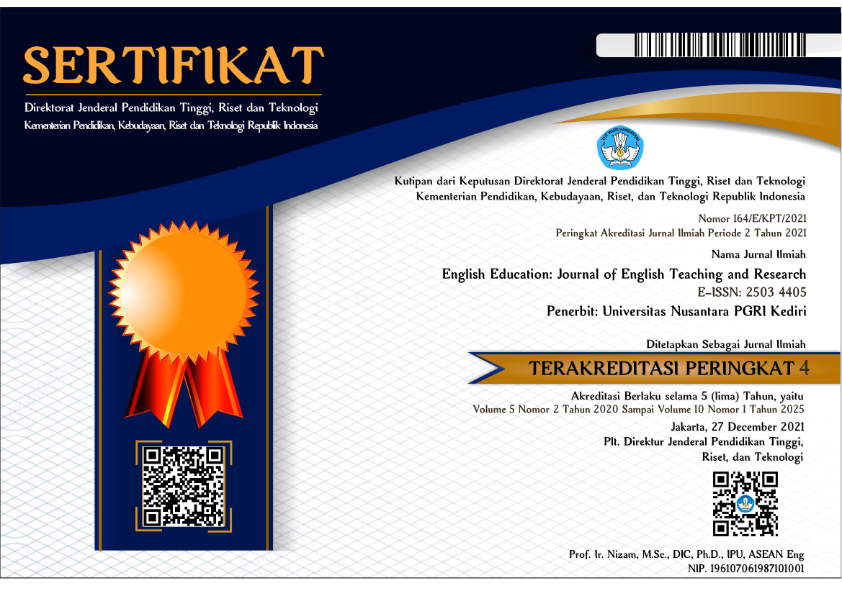The Effectiveness of Speech-Ace Website on Students’ Pronunciation
DOI:
https://doi.org/10.29407/jetar.v9i1.22372Keywords:
Keyword: SpeechAce, Pronunciation, Mixed-methodAbstract
Effective communication is the core of an EFL program. Therefore, having good pronunciation is crucial to achieve effective communication and to avoid misunderstanding. Speech-Ace is a tool that helps to enhance pronunciation in the form of a website. This study aims to discover the effectiveness of Speech-Ace on English Education Department student's pronunciation. Qualitative approach with case study method was used in this study, the data were gathered through pronunciation tests and interviews. The result showed that there was improvement in student's pronunciation after the implementation of Speech-Ace website. Students were helped by the feedback from the Speech-Ace website in enhancing their pronunciation skills. However, the study's generalizability is limited by the small sample size of 30 students. Further research with a larger and more representative population could strengthen the validity of the findings.
Downloads
References
Abbasova, M. & Mammadova, N. (2019). The Role of Digital Technology in English Language Teaching in Azerbaijan. International Journal of English Linguistics. 9(2), 370.researchgate.net/publication/331478653_The_Role_of_Digital_Technology_in_English_Language_Teaching_in_Azerbaijan
AbdAlgane, M., & Idris, S. A. M. (2020). Challenges of Pronunciation to EFL Learners in Spoken English. Social Science Research Network. https://ssrn.com/abstract=4563772
Alrajafi, G. (2021). The use of English in Indonesia: Status and Influence. SIGEH ELT : Journal of Literature and Linguistics, 1(1), 1–10. https://doi.org/10.36269/sigeh.v1i1.35
Alamudi, J. (2018). Student’s perception on the use of Duolingo as English learning media in android. Presented to Universitas Brawijaya in partial fulfillment of the requirements for the degree of Sarjana Pendidikan (S.Pd) in English Language Education Program, Faculty of Cultural Study of Universitas Brawijaya. http://repository.ub.ac.id/166612/1/JEEHAN%20ALAMUDI.
Ahmadi D M R. (2018). The Use of Technology in English Language Learning: A Literature Review. IJREE: International Journal of Research in English Education 2018; 3. http://ijreeonline.com/article-1-120-en.html
Andini, P., & Zaitun, Z. (2023). The Effectiveness of Learning Pronunciation Through English Content by English With Lucy on YouTube. Jurnal Studi Guru Dan Pembelajaran, 5(2), 201–206. https://doi.org/10.30605/jsgp.5.2.2022.1542
Asratie, M. G., Wale, B. D., & Aylet, Y. T. (2023). Effects of using educational technology tools to enhance EFL students’ speaking performance. Education and Information Technologies, 28(8), 10031–10051. https://doi.org/10.1007/s10639-022-11562-y
Bashori, M., Van Hout, R., Strik, H., & Cucchiarini, C. (2022). ‘Look, I can speak correctly’: learning vocabulary and pronunciation through websites equipped with automatic speech recognition technology. Computer Assisted Language Learning, 1–29. https://doi.org/10.1080/09588221.2022.2080230
Bećirović, S., Brdarević-Čeljo, A., & Delić, H. (2021). The use of digital technology in foreign language learning. SN Social Sciences, 1(10). https://doi.org/10.1007/s43545-021-00254-y
Chan, A., Li, S., & Lam, J. (2018). Evaluating the Effectiveness of Web SpeechAce in Improving English Pronunciation Accuracy. International Journal of Computer-Assisted Language Learning and Teaching, 8(4), 1-18. (https://doi.org/10.4018/IJCALLT.2018100101)
Chapelle, C. A., & Voss, E. (2016). 20 years of technology and language assessment in Language Learning & Technology. Language Learning & Technology, 20(2), 116–128. http://llt.msu.edu/issues/june2016/chapellevoss.pdf
Creswell, J. W., & Plano Clark, V. L. (2018). Designing and conducting mixed methods research (3rd ed.). Sage.
Diyyab, E. a. E., Abdel-Haq, E. M., & Aly, M. A. (2014). Using a Multimedia-Based program for developing student teachers’ EFL speaking fluency skills. Journal of Faculty of Education - Benha University, 25(99 P3), 1–28. https://doi.org/10.12816/0021993
Donal, A. (2016). Indonesian students’ difficulties in pronouncing English diphthongs. JEE (Journal of English Education), 2(2), 55-62. e-journal.upp.ac.id/index.php/jee/article/view/1305
Felix, J. J. (2020). Challenges in English as a foreign language (EFL) teaching and learning research: Why engagement with theory is needed to avoid disciplinary stagnation. In Stagnancy Issues and Change Initiatives for Global Education in the Digital Age (pp. 111–139). IGI Global. https://doi.org/10.4018/978-1-7998-4993-3.ch006
Galloway, N., & Rose, H. (2015). Introducing Global Englishes. Routledge. 11-12.
Hendriks, B., van Meurs, F., & Usmany, N. (2021). The effects of lecturers’ non-native accent strength in English on intelligibility and attitudinal evaluations by native and non-native English students. Language Teaching Research. https://doi.org/10.1177/1362168820983145
Kobilova, N. R. (2022). IMPORTANCE OF PRONUNCIATION IN ENGLISH LANGUAGE COMMUNICATION. Academic Research in Educational Sciences, 3(6). 0,89 , SIS: 1,12 , SJIF: 5,7 , UIF: 6,1.
Lauder, A. F. (2020). English in Indonesia. The Handbook of Asian Englishes, 605–627. https://doi.org/10.1002/9781118791882.ch26
Levelle, K., & Levis, J. (n.d.). (2014). 5 Understanding the Impact of Social Factors on L2 Pronunciation: Insights from Learners. http://dx.doi.org/10.1515/9781614511762.97
Muslim, U., Al, N., & Al Washliyah, W. (2020). Pelatihan aplikasi SpeechAce untuk peningkatan kefasihan berbahasa inggris pada guru-guru MTs Al Jam’iyatul wasliyah dalu X A Kabupaten Deli Serdang Sumatera Utara. Jurnal Pengabdian Kepada Masyarakat, 4(2), 135–138. https://jurnal-lp2m.umnaw.ac.id/index.php/AJPKM
Maraden, R., & Silalahi, P. (2016). Pronunciation Problems of Indonesian EFL Learners: An Error Analysis. In Journal of English Language and Culture (Vol. 6, Issue 2).
Mauludin, Lutfi. (2015). THE IMPORTANCE OF NON-NATIVE ENGLISH SPEAKER TEACHERS IN THE CONTEXT OF ENGLISH AS A FOREIGN LANGUAGE. https://www.researchgate.net/publication/341423512
Mayor, L. A. (2021). Overcoming segmental difficulties in English pronunciation in Spanish 3-ESO bilingual students through the use of SpeechAce. Universidad De Valladolid. https://uvadoc.uva.es/handle/10324/52671
McCrocklin, S., & Link, S. (2016). Accent, identity, and a fear of loss? ESL students’ perspectives. In Canadian Modern Language Review (Vol. 72, Issue 1, pp. 122–148). University of Toronto Press. https://doi.org/10.3138/cmlr.2582
Mohammed, M. H. (2018). International Journal of Social Science and Economic Research CHALLENGES OF LEARNING ENGLISH AS A FOREIGN LANGUAGE (EFL) BY NON-NATIVE LEARNERS. www.ijsser.org
Monika, Winarti, N, Yundayani, A (2019). English Pronunciation Learning in EFL Context: Students’ Voice. Journal of English Language and literature, 4(2), 68-73. https://doi.org/10.37110/jell.v4i02.82
Nakai, S., Beavan, D., Lawson, E., Leplâtre, G., Scobbie, J. M., & Stuart-Smith, J. (2018). Viewing speech in action: speech articulation videos in the public domain that demonstrate the sounds of the International Phonetic Alphabet (IPA). Innovation in Language Learning and Teaching, 12(3), 212–220. https://doi.org/10.1080/17501229.2016.1165230
Pardede, P. (2018). Improving EFL Students' English Pronunciation by Using the Explicit Teaching Approach. JET: Journal of English Teaching. 4. 143-155. https://doi.org/10.33541//vol4iss3pp143
Pennington, M. C. (2021). Teaching Pronunciation: The State of the Art. RELC Journal, 52(1), 3-21. https://doi.org/10.1177/00336882211002283
Rukoya, F. (2022). Junior High School student’s perceptions toward English pronunciation. Submitted in Partial Fulfilment of the Requirements of the Degree of Sarjana Pendidikan (S.Pd) in English Language Education Program, Faculty of Language and Arts of Universitas Kristen Satya Wacana Salatiga. T1_112017068_Judul.pdf (uksw.edu)
Sun W (2023) The impact of automatic speech recognition technology on second language pronunciation and speaking skills of EFL learners: a mixed methods investigation. Front. Psychol. 10.3389/fpsyg.2023.1210187
Syafrizal, S., Cahyaningrum, N. S., & Syamsun, T. R. (2022). Duo Lingo Application for Teaching Speaking Skills Class: Students’ Perception of Speech Ability. IDEAS: Journal on English Language Teaching and Learning, Linguistics and Literature, 10(1), 1041–1049. doi.org/10.24256/ideas.v10i1.2881
Takahashi, R. (2014). An analysis of ELF-oriented features in ELT coursebooks. English Today, 30(1), 28–34. doi.org/10.1017/S0266078413000539
Terentyeva, K. S., & Ulugbek, O. K. G. (2019). Giving and Receiving Feedback. Journal of Linguistics and Literature, 3(1), 5–10. doi.org/10.12691/jll-3-1-2
Thi-Nhu Ngo, T., Hao-Jan Chen, H., & Kuo-Wei Lai, K. (2023). The effectiveness of automatic speech recognition in ESL/EFL pronunciation: A meta-analysis. ReCALL, 1–18. doi.org/10.1017/s0958344023000113
Zawadzki, Z. (2022). Technology review: The Perfect Accent App. In J. Levis & A. Guskaroska (eds.), Proceedings of the 12th Pronunciation in Second Language Learning and Teaching Conference, held June 2021 virtually at Brock University, St. Catharines, ON. https://doi.org/10.31274/psllt.14315
Downloads
Published
Issue
Section
License
Copyright (c) 2024 anggytha mutiara, Salma Chusna Wakhda, Ismi Maryam Alfidariyani, Lilia Indriani

This work is licensed under a Creative Commons Attribution-ShareAlike 4.0 International License.
Authors who publish with this journal agree to the following terms:
- Copyright on any article is retained by the author(s).
- The author grants the journal, the right of first publication with the work simultaneously licensed under a Creative Commons Attribution License that allows others to share the work with an acknowledgment of the work’s authorship and initial publication in this journal.
- Authors are able to enter into separate, additional contractual arrangements for the non-exclusive distribution of the journal’s published version of the work (e.g., post it to an institutional repository or publish it in a book), with an acknowledgment of its initial publication in this journal.
- Authors are permitted and encouraged to post their work online (e.g., in institutional repositories or on their website) prior to and during the submission process, as it can lead to productive exchanges, as well as earlier and greater citation of published work.
- The article and any associated published material is distributed under the Creative Commons Attribution-ShareAlike 4.0 International License








 Article template
Article template



